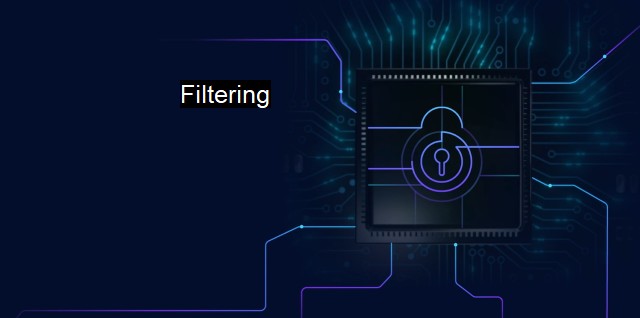What is Filtering?
Filtering in Cybersecurity: Mitigating Threats and Improving Productivity Through Selective Traffic Control Measures
Filtering in the context of cybersecurity and antivirus involves the process of screening, distinguishing, and managing the flow and access of data in a computer system or network to protect against malicious activities and unwanted content. It's a fundamental aspect of strengthening computer security and ensuring the seamless and protected operation of a system in a highly digitalized world.Primarily, an essential function of filtering in cybersecurity is to manage traffic within networks. Given the nature of cyberspace where both legitimate and harmful traffic can circulate, filtering tools help in discerning unusual patterns or behaviors that might constitute a threat to the system. Firewalls are a typical example of network filters, which chronically monitor incoming and outgoing traffic in a system. They fiddled out potential threats and neutralize them before any harm is wreaked on a system’s hardware or software.
Filtering is also inherent in antivirus programs. Antivirus software scans the system's data to identify possible viruses or malware based on specific threat signatures. It filters the system for similarities in characteristics with those present in previously detected threats from their virus databases. New and unknown threats are counteracted using sophisticated machine-learning systems to observe common methods and behaviors in harmful program codes, predicting and quarantining imminent threats during this activity.
Internet filters are other prominent manifestations of filtering. Used for web filtering, these filters check the credibility of websites by cross-referencing a database of sites known to contain malware or malicious content. Any website on this list is then blocked, protecting the system from possible threats. These web filters are expectedly rigid, as they have to constantly adapt to the ever-changing nature of internet threats.
Filtering plays a significant role in spam detection and management. A central battleground in today's cybersecurity threats is email, where phishing attacks are rampant. Email filters help in governing incoming and outgoing emails, blocking those emanating from unknown sources or containing suspicious content. Spam, specifically, is relegated to a separate folder for safe examination, preventing it from doing any substantial harm to the recipient’s system and information database.
In cloud computing, as organizations move to store and handle their precious data remotely, threats are larger and more complex. Cloud filters are, therefore, necessary in protecting this vast and vulnerable trove of data. They perform varied tasks, including auditing data for access, authorization, and classification, examining incoming and outgoing network traffic, encrypting data to ensure its safety, and many more.
Indeed, filtering adds a significant layer of security in processing large chunks of data and information, helping to ward off potential cybersecurity threats. Filters are vital for vetting the data, traffic, emails, and other elements that are subject to cyber-attacks. In contemporary times where cybercriminals are ever-advanced in their methodologies, filters – be they in networks, antiviruses, emails, or clouds – are getting smarter and robust.
To round off, the ecosystem of cybersecurity and antivirus is a vast field, having multiple components working against an array of sophisticated cyber threats. In one sense, 'filtration' is the sieve in this domain. By charting an intricate line of defense that listens, identifies, learns, and reacts, filtering forms a formidable force against digital ages’ ever-persistent online threats. Its meticulousness and precision in warding off unwanted interruptions and unauthorized access help maintain cyber-hygiene and upkeep a resilient and reliable cybersecurity infrastructure. Advances in this niche – artificial intelligence, machine learning, next-generation antivirus – are ultimately making filtering more powerful and capable of tackling the ongoing and emerging threats in the landscape of cybersecurity.

Filtering FAQs
What is filtering in cybersecurity?
Filtering in cybersecurity refers to the process of selectively allowing or blocking data traffic based on pre-defined criteria. It is a crucial technique used by antivirus programs to prevent malware and other online threats from infiltrating computer systems.What types of filtering techniques are commonly used in antivirus software?
Antivirus software typically employs several filtering techniques, such as content filtering, packet filtering, and URL filtering. Content filtering involves analyzing the content of data packets to determine if they contain malicious code, while packet filtering looks at the header information of each packet to determine if it meets certain criteria. URL filtering involves blocking access to specific websites based on their URL or domain name.How does filtering help improve cybersecurity?
Filtering is an essential component of cybersecurity because it helps prevent malicious traffic from reaching vulnerable computer systems. By selectively allowing only legitimate traffic while blocking malicious traffic, filtering can significantly reduce the risk of cyberattacks and malware infections. Additionally, filtering can help organizations comply with regulatory requirements and protect sensitive data from unauthorized access.Can filtering be bypassed by hackers or malware?
While filtering can be an effective tool for improving cybersecurity, it is not foolproof and can be bypassed by skilled hackers or advanced malware. Hackers may use techniques such as IP spoofing or encrypted traffic to bypass packet filtering, for example. However, antivirus software vendors continually update their filtering algorithms to stay ahead of new and evolving threats, making it more difficult for hackers to bypass them.| | A | | | B | | | C | | | D | | | E | | | F | | | G | | | H | | | I | | | J | | | K | | | L | | | M | |
| | N | | | O | | | P | | | Q | | | R | | | S | | | T | | | U | | | V | | | W | | | X | | | Y | | | Z | |
| | 1 | | | 2 | | | 3 | | | 4 | | | 7 | | | 8 | | |||||||